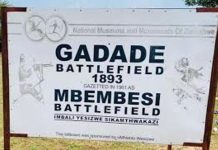Africa-Press – Zimbabwe. TUCKED away in the sprawling settlement of Caledonia, just outside Harare, lies a gem that shines in the midst of darkness.
For first time visitors, it is no doubt that the recently constructed Runyararo Peace Primary School has brought along with it value in Caledonia, where modern infrastructure is alien.
For decades, Caledonia had no government school despite being one of the biggest settlements in the country.
Recently, Primary and Secondary Education minister Torerai Moyo officially opened the school that was constructed with the help of residents and the Church of Jesus Christ of Latter-Day Saints before being handed over to government.
But according to residents, the journey was not easy at all as more than 500 young learners had to learn from “reject tents” that were donated as Cyclone Idai leftovers from Chimanimani.
“As the school’s name suggests, we are now at peace, it was a never easy journey,” recalled Wellington Chirimba, the spokesperson of Caledonia Residents Association Trust (CRAT).
CRAT is an organisation that has members from Caledonia that champion development, including construction of critical infrastructure and establishing vital social amenities in the area.
“It took us several years for the school to be established. As residents, we knocked each and every door until our plea was heard,” Chirimba told NewsDay Weekender.
“Today, we are happy that we now have a government school on Caledonia, the first of its kind in this vast area.
“At one point, land barons invaded the school ground and sold it to someone who wanted to construct a private school, but as CRAT, we stood our ground and fought bravely to reclaim the land.”
A visit to the school denoted neatly constructed classroom blocks equipped with modern learning facilities and a thriving water reticulation system.
As of last week, the school had an enrolment of 727.
Caledonia, which emerged after the 2005 Operation Murambatsvina, is a rapidly growing informal settlement located about 30km east of Harare.
It now falls under Goromonzi Rural District Council in Mashonaland East province, both politically and administratively after the Presidential Proclamation of 2018.
This was after Harare Metropolitan was claiming that the area fell within its jurisdiction, thereby creating confusion.
Politically, it is also under Goromonzi South constituency.
Characterised by haphazard planning and disoderly allocation of land, Caledonia has an estimated population of over 450 000.
The area has been a hunting ground for land barons who are still selling land and open spaces to desperate home-seekers.
There are no proper roads and water systems in the settlement, while government is yet to establish a clinic, leaving residents at the mercy of private health centres.
According to CRAT, Caledonia has a total a total of 34 grounds earmarked for schools construction.
However, most of the grounds have been invaded by land barons.
“As residents, we are moving on to ensure that we have more government schools in Caledonia. We have more than 34 spaces reserved for schools and we will fight until all those schools are constructed,” Chirimba said.
“With the commissioning of Runyararo Peace Primary School, residents now see the light and are now of the view that with unity and resilience, it can happen.”
Added Chirimba: “For several years, we laboured to construct Runyararo Primary School and during the first months, our children were learning in refuge tents.
“We had 19 teachers for the over 450 learners who stood with us despite the conditions.
“We had to hire ablution facilities daily and some well wishers donated water bowsers. It was scary.”
Chirimba narrated how residents under CRAT engaged the Church of Jesus Christ of Latter-Day Saints, who then moved to construct five blocks at the school.
The church then requested that the residents had to kickstart the project first to enable them to unlock funds.
CRAT then constructed toilets, drilled a borehole and erected tents that came from Manicaland province before the church moved in.
“They are our angels. They came at an opportune time when all hope was lost,” Chirimba said.
“They moved with speed and today, our children are learning in what is undoubtedly one of the best schools in the country.”
Former Goromonzi South legislator and CRAT founding member, Petronella Kagonye, narrated how residents united to promote development in the area.
“I remember I was the MP that time and residents came together for a common purpose. They wanted to bring development in the area and it has happened,” she said.
“I am happy that CRAT has been hands-on in the establishing of this school.
“I can confidently say it is the residents under CRAT who came up with the school name and designed the school’s uniform.”
During the commissioning of the school, Moyo , the Primary and Secondary Education minister, hailed the unity that gave birth to the new learning centre.
CRAT chairperson Trust Moyo Zvakurumbira said residents have vowed to lead in the construction of more government schools.
“Our dream is to at least to construct a school each year across Caledonia for the better of our education system,” Moyo said.
“Currently, we have learners travelling to nearby Goromonzi North, in Mapfeni to school, but we have space for schools here.”
Today, Runyararo Peace Primary School is a modern oasis that defies the expectations of a community often plagued by poverty and neglect.
It is a learning centre that stands as a symbol of a community’s resilience and sheer hard work in ensuring availability of modernity in its area.
For More News And Analysis About Zimbabwe Follow Africa-Press






